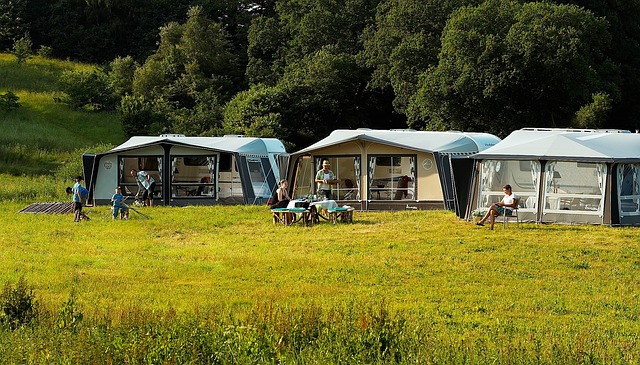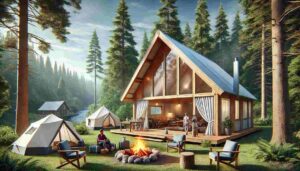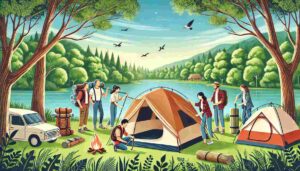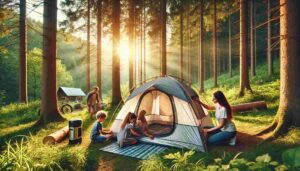Camping is a wonderful way to disconnect from the hustle and bustle of daily life and enjoy the beauty of nature. However, a successful camping trip requires more than just a tent and a sleeping bag. To ensure a comfortable and enjoyable experience, it’s important to have the right gear. In this article, I’ll cover the top 9 must-have camping gear items that will make your trip successful.
Whether you’re a seasoned camper or planning your first trip, these essential items will ensure you have everything you need to make the most of your time in the great outdoors. So, pack your bags, and let’s get started!
1. Tent
A high-quality tent is the cornerstone of any successful camping trip. It provides shelter from the elements, privacy, and a comfortable place to rest at night. When choosing a tent, consider the duration of your camping trip, the location, and the number of people in your group. Here are some tips for choosing the right tent:
- Size: Make sure the tent is spacious enough to accommodate everyone comfortably. Consider the number of people in your group and whether you’ll need extra space for gear.
- Ease of setup: Look for a tent that is easy to set up and take down, especially if you’re a novice camper. Check online reviews to see how other users found the tent’s setup process.
- Durability: Choose a tent made from durable materials that can withstand harsh weather conditions. Look for features like reinforced stitching, sturdy poles, and weather-resistant coatings.
- Type: There are several types of tents, including backpacking tents, family tents, and dome tents. Consider the type of camping you’ll be doing and choose a tent that’s appropriate for your needs.
Some popular tent brands include REI, Big Agnes, and Coleman. With the right tent, you’ll have a comfortable home away from home during your camping trip.
2. Sleeping bag
A good quality sleeping bag is essential for a comfortable night’s sleep while camping. It provides insulation to keep you warm, and a comfortable place to rest. When choosing a sleeping bag, consider the duration of your camping trip, the location, and the climate. Here are some tips for choosing the right sleeping bag:
- Temperature rating: Choose a sleeping bag with a temperature rating appropriate for the weather conditions you’ll be camping in. Consider whether you tend to sleep cold or warm and choose a bag with a rating that reflects your needs.
- Insulation: There are two types of insulation: down and synthetic. Down is lighter and compresses more easily, but can be more expensive and less effective when wet. Synthetic insulation is less expensive and performs better in wet conditions.
- Size: Make sure the sleeping bag is the right size for your body. Consider your height and whether you’ll need extra space for comfort.
- Shape: Sleeping bags come in several shapes, including rectangular, mummy, and semi-rectangular. Mummy bags are best for cold-weather camping, while rectangular bags offer more room to move around.
Some popular sleeping bag brands include The North Face, Marmot, and Kelty. With the right sleeping bag, you’ll stay warm and comfortable throughout your camping trip.
3. Camping stove
A camping stove is a must-have item for any camping trip where you plan on cooking your own meals. It provides a reliable source of heat and allows you to prepare hot meals and drinks. When choosing a camping stove, consider the duration of your camping trip, the location, and your cooking needs. Here are some tips for choosing the right camping stove:
- Fuel type: Camping stoves can run on different types of fuel, including propane, butane, and white gas. Consider the availability of the fuel in your camping location and choose a stove that uses a fuel type that is easy to find.
- Ease of use: Choose a camping stove that is easy to use and has simple controls. Look for features like a built-in ignition system and adjustable flame control.
- Portability: Consider the size and weight of the stove, especially if you’ll be carrying it on a backpacking trip. Look for stoves that are lightweight and compact for easy transport.
- Cooking needs: Consider the types of meals you’ll be cooking and choose a stove with the appropriate number of burners and the cooking surface.
Some popular camping stove brands include Jetboil, Coleman, and MSR. With the right camping stove, you’ll be able to prepare hot meals and drinks and enjoy the comforts of home while camping.
4. Cooler
A cooler is an essential item for any camping trip where you plan on bringing food and drinks that need to be kept cool. It helps to prevent spoilage, keeping your food and drinks fresh for longer. When choosing a cooler, consider the duration of your camping trip, the location, and your storage needs. Here are some tips for choosing the right cooler:
- Size: Choose a cooler that is the right size for your storage needs. Consider the number of people in your group and the duration of your trip.
- Insulation: Look for a cooler with good insulation to keep your food and drinks cold for longer. High-quality coolers often have thick walls and lids, as well as foam insulation.
- Durability: Choose a cooler made from durable materials that can withstand harsh outdoor conditions. Look for features like reinforced corners, heavy-duty latches, and non-slip feet.
- Portability: Consider the size and weight of the cooler, especially if you’ll be carrying it on a backpacking trip. Look for coolers that are lightweight and have comfortable handles or straps for easy transport.
Some popular cooler brands include Yeti, Coleman, and Igloo. With the right cooler, you’ll be able to keep your food and drinks fresh and enjoy delicious meals and cold drinks while camping.
5. Lighting
Proper lighting is essential for any camping trip, providing safety and convenience during the day and night. When choosing to light, consider the duration of your camping trip, the location, and your activities. Here are 4 tips for choosing the right lighting:
- Brightness: Choose lighting that is bright enough to provide adequate illumination for your needs. Consider the size of your camping area and the activities you’ll be doing.
- Battery life: Look for lighting that has a long battery life or can be easily recharged. This will ensure that you have enough light throughout your camping trip.
- Portability: Consider the size and weight of the lighting, especially if you’ll be carrying it on a backpacking trip. Look for lighting that is lightweight and compact for easy transport.
- Type: There are several types of lighting, including lanterns, flashlights, and headlamps. Consider the activities you’ll be doing and choose the appropriate type of lighting.
Some popular lighting brands include Black Diamond, Goal Zero, and BioLite. With the right lighting, you’ll be able to see and navigate your camping area, cook meals after dark, and enjoy nighttime activities safely and conveniently.
6. First aid kit
A first aid kit is an essential item for any camping trip, providing essential medical supplies in case of emergencies. When choosing a first aid kit, consider the duration of your camping trip, the location, and your activities. Here are some tips for choosing the right first aid kit:
- Contents: Look for a first aid kit that includes all the essential medical supplies you may need, such as bandages, antiseptic wipes, gauze pads, and adhesive tape. Consider any specific medical needs of your group, such as prescription medications or allergies.
- Size: Choose a first aid kit that is the right size for your needs. Consider the number of people in your group and the duration of your trip.
- Accessibility: Look for a first aid kit that is easy to access and use. Consider the design of the kit, such as a zippered pouch or roll-up design, to ensure that you can quickly access the supplies you need in case of an emergency.
- Durability: Choose a first aid kit made from durable materials that can withstand outdoor conditions. Look for features like a waterproof or crush-proof case.
Some popular first-aid kit brands include Adventure Medical Kits, Lifeline, and Coleman. With the right first aid kit, you’ll be prepared to handle any medical emergency that may arise during your camping trip.
7. Water filtration system
A water filtration system is an essential item for any camping trip where you plan on drinking or cooking with water from natural sources, such as rivers or lakes. It helps to remove harmful bacteria, parasites, and other contaminants from the water, making it safe to drink. When choosing a water filtration system, consider the duration of your camping trip, the location, and the water sources available. Here are 4 tips for choosing the right water filtration system:
- Filtration method: There are several types of water filtration methods, including pumps, gravity filters, and straw filters. Choose a filtration method that is appropriate for your needs and the water sources available.
- Capacity: Look for a water filtration system with a capacity that is appropriate for your group’s needs. Consider the number of people in your group and the duration of your trip.
- Portability: Consider the size and weight of the filtration system, especially if you’ll be carrying it on a backpacking trip. Look for systems that are lightweight and compact for easy transport.
- Durability: Choose a water filtration system made from durable materials that can withstand outdoor conditions. Look for features like a durable filter, a sturdy case, and a robust pumping mechanism.
Some popular water filtration system brands include Katadyn, Sawyer, and LifeStraw. With the right water filtration system, you’ll be able to safely drink and cook with water from natural sources, reducing the need to carry heavy water supplies with you.
8. Multi-tool
A multi-tool is a versatile item that is useful for a variety of tasks during a camping trip. It can help you prepare meals, set up camp, and handle small repairs. When choosing a multi-tool, consider the duration of your camping trip, the location, and your activities. Here are some tips for choosing the right multi-tool:
- Size: Choose a multi-tool that is the right size for your needs. Consider the tasks you’ll be using it for and the amount of space you have available in your camping gear.
- Functions: Look for a multi-tool with a variety of functions, such as a knife, scissors, pliers, screwdrivers, and can openers. Consider the activities you’ll be doing and choose a multi-tool with functions that will be useful for those activities.
- Durability: Choose a multi-tool made from durable materials that can withstand outdoor conditions. Look for features like stainless steel construction, rust-resistant coatings, and a strong locking mechanism.
- Portability: Consider the size and weight of the multi-tool, especially if you’ll be carrying it on a backpacking trip. Look for tools that are lightweight and compact for easy transport.
Some popular multi-tool brands include Leatherman, Gerber, and Victorinox. With the right multi-tool, you’ll have a versatile tool that can handle a variety of tasks during your camping trip.
9. Navigation tools
Navigation tools are important for any camping trip, providing a way to navigate and explore the outdoors safely and efficiently. When choosing navigation tools, consider the duration of your camping trip, the location, and the terrain. Here are some tips for choosing the right navigation tools:
- Accuracy: Choose navigation tools that are accurate and reliable. Look for features like GPS, compasses, and maps that can help you navigate accurately.
- Ease of use: Look for navigation tools that are easy to use and understand, especially if you’re a novice camper. Consider whether the tool requires batteries, how to use the device, and whether it provides clear directions.
- Portability: Consider the size and weight of the navigation tools, especially if you’ll be carrying them on a backpacking trip. Look for tools that are lightweight and compact for easy transport.
- Terrain: Consider the type of terrain you’ll be navigating and choose tools appropriate for those conditions. For example, if you’ll be hiking in the mountains, a topographic map and compass may be useful.
Some popular navigation tool brands include Garmin, Suunto, and Silva. With the right navigation tools, you’ll be able to explore the outdoors safely and efficiently, making the most of your camping trip.
Conclusion
In conclusion, having the right camping gear can make all the difference in ensuring a successful camping trip. From a high-quality tent to a water filtration system, each piece of gear serves a unique purpose in providing comfort, safety, and convenience while enjoying the great outdoors.
By following the tips provided in this article, you can choose the essential camping gear items that are appropriate for your needs and enjoy a comfortable and enjoyable camping experience. So, pack your bags, grab your gear, and get ready for an unforgettable adventure in the great outdoors!










